Home | Airshows | The Hangar | Nostalgia | f4's F4s | Wattisham Chronicles | Links |
||||||||||||||||||
Royal
International Air Tattoo Part three: Tributes, Tornados & T'other things Gary Parsons looks at some of the other aspects of RIAT 2001. All pictures by the author unless stated otherwise.
Tributes
Johnnie Johnson, who lived most of his life in Leicestershire, was the highest scoring fighter ace to survive World War II, and was also Station Commander at RAF Cottesmore from 1957 to 1960. He made 38 confirmed kills against the Luftwaffe and was awarded a CBE, DSO and two bars, DFC and bar, the Belgian Legion of Honour and the Croix de Guerre.
Today's Station Commander, Group Captain David Walker, said "Air-Vice Marshal Johnson's RAF career saw a remarkable evolution in aviation, from propellers to jet power. It is therefore most apt that his memorial tribute should combine both types of aircraft, and RAF Cottesmore is honoured to play its part." PS853 was built at Supermarine’s factory at Southampton, in January 1944. As her last World War II operation, she joined 16 Squadron to fly nine missions on 'Operation crossbow' against V-weapon sites. In peacetime she operated as a meteorological research aircraft at RAF Woodvale, and carried out the last working flight of a Royal Air Force Spitfire on 10 June 1957. Four days later PS853 found a new home with the Battle of Britain Memorial Flight (BBMF). For thirty-seven years she took to the air with the BBMF, taking time out to star in the film 'Battle of Britain' and to engage in combat trials with the then new Lightning fighter. In 1994, when the BBMF needed to raise money to rebuild a Hurricane, PS853 was privately sold. Rolls-Royce purchased the Spitfire on 12 September 1996 and she began flying again, delighting audiences with the distinctive sound of the Rolls-Royce Griffon engine.
Brian Trubshaw, who died in March, aged 77, was a test pilot for thirty years and became famous for piloting Concorde through its maiden flight in Britain. He flew the British-assembled Concorde 002 from Filton in Bristol to RAF Fairford in Gloucestershire, on 9 April 1969. "It was a wizard flight," he said. "Many test pilots would have given almost anything to be in my shoes and I well appreciated how lucky I was." He later placed a weather vane depicting the plane on the roof of his house at Cherington, near Tetbury in Gloucestershire. Ernest Brian Trubshaw was born on 29 January 1924. He had been captivated by flying since the age of ten, when he saw the Prince of Wales's aircraft land on the beach at Pembrey, Carmarthenshire, not far from where his family lived. In 1942 he signed up for the RAF, training on a Stearman biplane in America. He joined Bomber Command in 1944, flying Stirlings and Lancasters, before transferring to Transport Command. After the war he left the service to become a test pilot for Vickers-Armstrong, where he remained for thirty years, becoming chief test pilot in 1960, and director of test flights from 1966. Trubshaw worked on the development of the Valiant V-bomber, the Vanguard, the VC-10, and the BAC-111, all of which he test flew.
Trubshaw ended his career as divisional director and general manager of the Filton works of British Aerospace from 1980-1986. From 1986-1993 he was a member of the board of the Civil Aviation Authority, and worked as an aviation consultant. At Cottesmore there was some disappointment, as it was thought that a formation of Red Arrows with trailing VC-10 was planned, but in the end a lone ’10 was followed a couple of minutes later by the Reds. An opportunity missed for a unique formation, especially with the inability to get Concorde for the occasion. As Trubshaw was heavily involved with the design and development of Vickers’ last great airliner, it was a fitting substitute for the grounded supersonic Anglo-French jet. Although Concorde has at last begun test flying with a view to being back in service by the end of the year, it is just a shame that 'Trubby' never saw her back where she belongs.
By gum, t'were a lot of Tornados. RAF, Italian and Germans were present in vast numbers, including a plastic GR4 for the great unwashed to sit in. Most colourful was 46+44 in its glorious Tiger scheme, on one of its many outings this year, but one could never tire of seeing it in all its splendour. Italian F3s were plentiful, although we were denied to see the recently-painted ‘devil’ paint scheme and had to make do with some rather more austere examples. Displays came from 56(R) Squadron’s F3 display crew and the German Navy with MFG-2, although it was surprising that 15(R) Squadron were missing with the GR1 demonstration. Hunter's 50th anniversary (continued)
Power & the glory...
30th birthday bonanza
Next week: A FRIAT virgin writes...
|
||||||||||||||||||
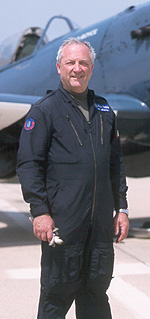
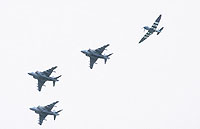
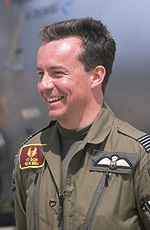
 When Johnnie Johnson took over as
Station Commander at RAF Cottesmore in 1957, he oversaw preparations to transform the
Station into the UK's V-Force base. 10 Squadron, and their brand- new Victor B1 Bombers,
arrived in April 1958.
When Johnnie Johnson took over as
Station Commander at RAF Cottesmore in 1957, he oversaw preparations to transform the
Station into the UK's V-Force base. 10 Squadron, and their brand- new Victor B1 Bombers,
arrived in April 1958.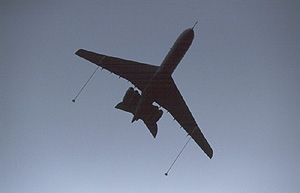 Tribute to 'Trubby'
Tribute to 'Trubby'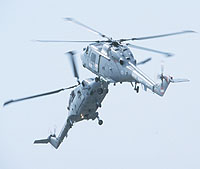 In 1962, the British and
French governments signed an agreement to develop a supersonic transport aircraft, to be
called Concorde. The chairman of BAC, George Edwards, selected Trubshaw as test pilot.
Development of the aircraft proved problematic as costs rose from £140 million to more
than £280 million. But despite some political opposition to the project, Trubshaw piloted
Concorde on its first British flight.
In 1962, the British and
French governments signed an agreement to develop a supersonic transport aircraft, to be
called Concorde. The chairman of BAC, George Edwards, selected Trubshaw as test pilot.
Development of the aircraft proved problematic as costs rose from £140 million to more
than £280 million. But despite some political opposition to the project, Trubshaw piloted
Concorde on its first British flight. 
















